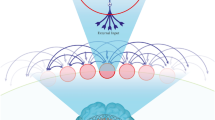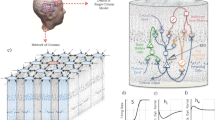Abstract
A model of coupled neural masses can generate seizure-like events and dynamics similar to those observed during interictal to ictal transitions and thus can be used for theoretical study of the control of epileptic seizures. In an effort to understand the mechanisms underlying epileptic seizures and how to avoid them, we added a control input to this model. Epileptic seizures are always accompanied by hypersynchronous firing of neurons, so research on synchronization among cortical areas is significant for seizure control. In this study, principal component analysis (PCA) was used to identify synchronization clusters composed of several neural masses. A method for calculating the synchronization cluster strength and participation rate is presented. The synchronization cluster strength can be used to identify synchronization clusters and the participation rate can be employed to identify neural masses that participate in the clusters. Each synchronization cluster is controlled as a whole using a proportional-integral-derivative (PID) controller. We illustrate these points using coupled neural mass models of synchronization to show their responses to increased (between node) coupling with and without control. Experiment results indicated that PID control can effectively regulate synchronization between neural masses and has the potential for seizure prevention.





Similar content being viewed by others
References
Bartolomei F, Wendling F, Bellanger JJ, Regis J, Chauvel P (2001) Neural networks involving the medial temporal structures in temporal lobe epilepsy. Clin Neurophysiol 112(9):1746–1760
Bikson M, Fox JE, Jefferys JGR (2003) Neuronal aggregate formation underlies spatiotemporal dynamics of nonsynaptic seizure initiation. J Neurophysiol 89:2330–2333
Breakspear M, Roberts JA, Terry JR, Rodrigues S, Mahant N, Robinson PA (2006) A unifying explanation of primary generalized seizures through nonlinear brain modeling and bifurcation analysis. Cereb Cortex 16(9):1296–1313
Buzsáki G (2004) Large-scale recording of neuronal ensembles. Nat Neurosci 7:446–451
Buzsáki G, Draguhn A (2004) Neuronal oscillations in cortical networks. Science 304:1926–1929
Chakravarthy N, Sabesan S, Tsakalis K, Iasemidis L (2009) Controlling epileptic seizures in a neural mass model. J Comb Optim 17(1):98–116
Chawla D, Lumer ED, Friston KJ (1999) The relationship between synchronization among neuronal populations and their mean activity level. Neural Comput 11(6):1389–1411
Chawla D, Friston KJ, Lumer ED (2001) Zero-lag synchronous dynamics in triplets of interconnected cortical areas. Neural Netw 14(6–7):727–735
David O, Friston KJ (2003) A neural mass model for MEG/EEG: coupling and neuronal dynamics. NeuroImage 20(3):1743–1755
Desai NS, Rutherford LC, Turrigiano GG (1999) Plasticity in the intrinsic excitability of cortical pyramidal neurons. Nat Neurosci 2:515–520
Fox JE, Bikson M, Jefferys JGR (2007) The effect of neuronal population size on the development of epileptiform discharges in the low calcium model of epilepsy. Neurosci Lett 411:158–161
Golowasch J, Casey M, Abbott LF, Marder E (1999) Network stability from activity-dependent regulation of neuronal conductances. Neural Comput 11(5):1079–1096
Gunduz A, Principe JC (2009) Correntropy as a novel measure for nonlinearity tests. Signal Process 89(1):14–23
Houweling AR, Bazhenov M, Timofeev I, Steriade M, Sejnowski TJ (2005) Homeostatic synaptic plasticity can explain post-traumatic epileptogenesis in chronically isolated neocortex. Cereb Cortex 15(6):834–845
Jansen BH, Rit VG (1995) Electroencephalogram and visual evoked potential generation in a mathematical model of coupled cortical columns. Biol Cybern 73(4):357–366
Jansen BH, Zouridakis G, Brandt ME (1993) A neurophysiologically-based mathematical model of flash visual evoked potentials. Biol Cybern 68(3):275–283
Kim JW, Roberts JA, Robinson PA (2009) Dynamics of epileptic seizures: evolution, spreading, and suppression. J Theor Biol 257(4):527–532
Liley DTJ, Bojak I (2005) Understanding the transition to seizure by modeling the epileptiform activity of general anesthetic agents. J Clin Neurophysiol 22(5):300–313
Robinson PA, Rennie CJ, Rowe DL (2002) Dynamics of large-scale brain activity in normal arousal states and epileptic seizures. Phys Rev E 65(4):41924
Suffczynski P, Wendling F, Bellanger JJ, Lopes Da Silva FH (2006) Some insights into computational models of (patho) physiological brain activity. Proc IEEE 94(4):784–804
Turrigiano GG, Nelson SB (2004) Homeostatic plasticity in the developing nervous system. Nat Rev Neurosci 5(2):97–107
Wendling F, Bellanger JJ, Bartolomei F, Chauvel P (2000) Relevance of nonlinear lumped-parameter mod-els in the analysis of depth-EEG epileptic signals. Biol Cybern 83(4):367–378
Wendling F, Bartolomei F, Bellanger JJ, Chauvel P (2001) Interpretation of interdependencies in epileptic signals using a macroscopic physiological model of the EEG. Clin Neurophysiol 112(7):1201–1218
Wendling F, Bartolomei F, Bellanger JJ, Chauvel P (2002) Epileptic fast activity can be explained by a model of impaired gabaergic dendritic inhibition. Eur J Neurosci 15(9):1499–1508
Wendling F, Hernandez A, Bellanger JJ, Chauvel P, Bartolomei F (2005) Interictal to ictal transition in human temporal lobe epilepsy: insights from a computational model of intracerebral EEG. J Clin Neurophysiol 22(5):343–356
Acknowledgments
This work was supported by the Program of Development of Science and Technology of Shandong under Grant 2010GSF10243 and the Independent Innovation Foundation of Shandong University under Grant 2012DX008.
Author information
Authors and Affiliations
Corresponding author
Rights and permissions
About this article
Cite this article
Ma, Z., Zhou, W., Geng, S. et al. Synchronization regulation in a model of coupled neural masses. Biol Cybern 107, 131–140 (2013). https://doi.org/10.1007/s00422-012-0541-3
Received:
Accepted:
Published:
Issue Date:
DOI: https://doi.org/10.1007/s00422-012-0541-3




